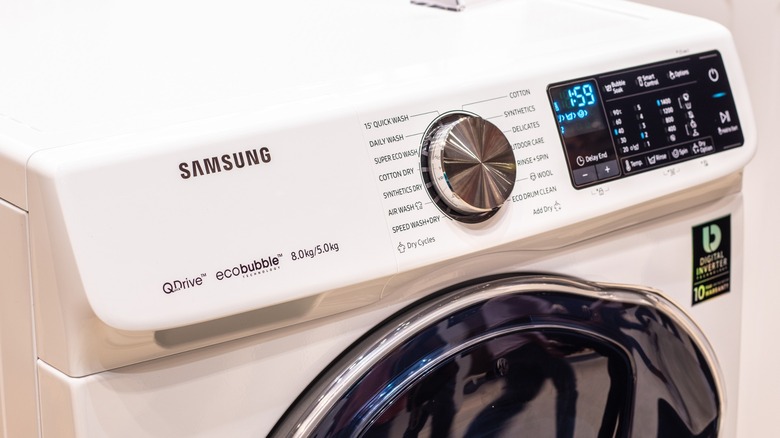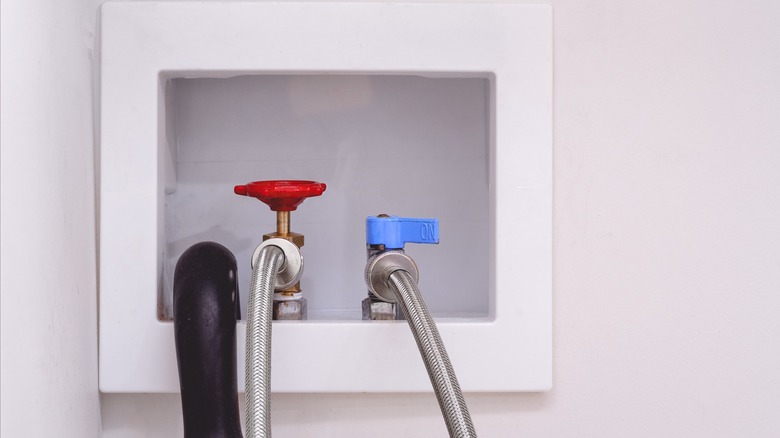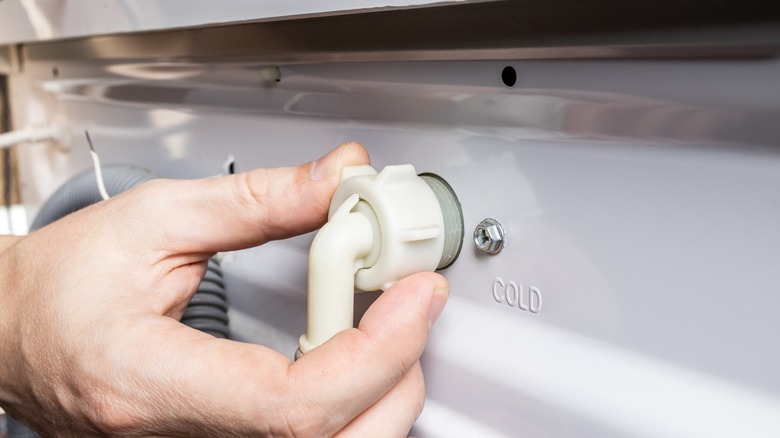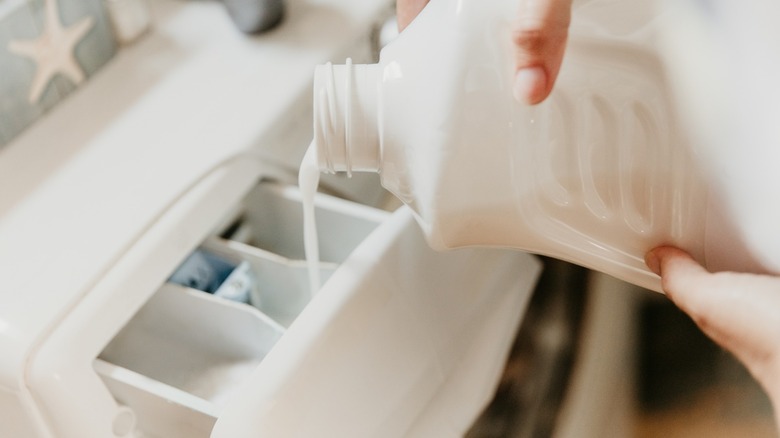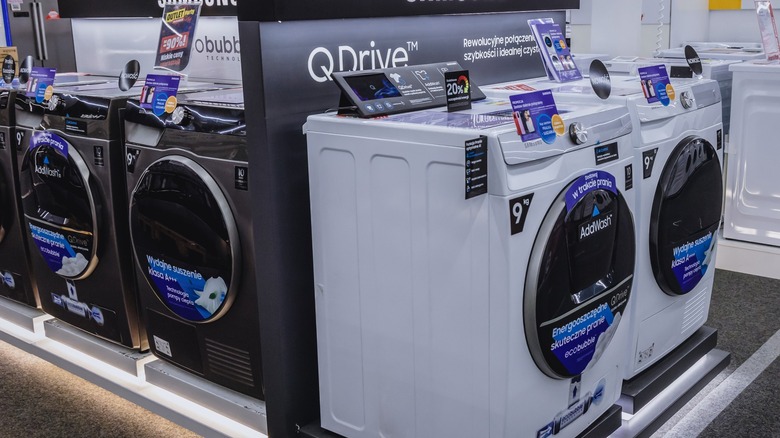Here's What The 4C Error Code On Your Samsung Washer Means
We may receive a commission on purchases made from links.
Few things are more frustrating than going to use your washer only to have it not work. Many consumers faced this pain with Samsung and sued over it in the mid-2010s. Thankfully, the brand has gotten better, but you may still see the occasional error. If your machine does malfunction and the code on the digital panel is "4C," you can breathe easily because the problem can typically be fixed with a few steps.
The 4C (or sometimes 4E) error code dictates that there's a potential issue with the washer's water supply and it's not filling properly. Unfortunately, the code doesn't indicate exactly what the issue is, and the Samsung washer can't suss it out without human intervention. However, don't rush to call a Samsung technician. There's no need to incur the cost, as repairing a 4C error code can be fairly easy.
It can be so easy that most fixes don't require tools to repair it. Since the error is related to a water supply issue, the focal point of your repairs will likely be the hose that runs from the Samsung washer to the water supply tap of your home.
Think you're ready to take on repairing the 4C error code and restoring the washer's water supply? We've broken down the most common fixes, as Samsung indicates below.
Check the water hoses running to the washer
Two common things can happen with the water hoses that run from your home's water supply to the washer. Let's start with the simplest one, which involves checking to make sure one or both of the hoses aren't being impacted by kinks, bends, or pinching.
To check if the water hoses are the problem:
- Turn off and unplug the washer
- Pull the washing machine away from the water supply for easy access
- Turn off the water supply at the tap (typically a red and blue handle)
- Thoroughly inspect the hoses to find damage or bending
If either hose is bent or kinked:
- Disconnect it from the washer
- Twist and adjust it as needed to remove the bend or kink
- Securely fasten the hoses' end to the washer
- Turn on the water supply
If you made any adjustments to a hose, run the washing machine through a light cycle while still in the room to ensure the issue is resolved and you didn't cause any damage to the hoses.
Is your mesh filter dirty?
Alternatively, your hose's mesh filter may be dirty. If you're not cleaning the filter twice a year, this is likely your culprit for the 4C code. The water that runs from your water line into the washer can be carrying debris or minerals. Mesh filters prevent foreign objects from getting into your washing machine and ruining your clothes or damaging the machine itself.
To clean the mesh filter, be sure to have a pair of pliers on hand. Then:
- Shut off the water supply
- Disconnect the hoses from your Samsung washer
- If there's an L-shaped attachment, remove that from the machine
- Using the pliers, pull out the mesh filters from the machine's valve
- Clean the filter by submerging it completely in water
- Let it sit for a few minutes, then brush or wipe away any buildup
- Remove the filter and let it sit (out of the sun) until dry
- Once dry, reinstall the filter
- Reconnect any attachments or hoses
- Turn on the water supply
Like in the previous fix, run the washing machine through a quick rinse to make sure the water is flowing as intended. If you're still having issues, there are two more areas you can check.
Clean the detergent dispenser drawer
Over time, gunk and other objects can cause a blockage in the detergent drawer. If you checked the mesh filter and verified the hoses are straight, there may be some buildup causing the 4C error and preventing water from running through your machine.
Like the mesh filter, you should clean your dispenser drawer occasionally to prevent issues from developing over time. To clean the drawer:
- Open the detergent drawer
- Find the release lever inside the drawer (near the softener compartment)
- Press the lever and pull the drawer out simultaneously
- Remove the detergent guide (in the left-most compartment)
- Remove the softener housing (in the center compartment)
- Rinse all parts, using a toothbrush or soft bristle brush to remove residue
- Using a toothbrush, clean the detergent drawer housing in the washer
- Replace all components and reinstall the drawer
- Run a rinse cycle to remove the remaining detergent
If you're using automatic dispensers for detergent, remove and rinse them separately. Open the lid, fill with water, and shake vigorously to loosen the buildup. Repeat steps eight and nine above to verify that the cleaning fixed the error code.
Other possible Samsung washer error codes you should watch for
While the 4C error code may be fairly easy to fix, it's not the only code that can pop up on your Samsung's digital panel. You can determine what may be wrong with your washer using the following codes:
- Cb, C6: Washer is calibrating
- SDC, 5DC: Detergent drawer isn't closed
- ddC, dC3: Add hatch is not registered as closed/locked
- nF, 4C, 4E, 1 4C: Water is not filling the washer properly
- nF1, 4C2, 4E2, CE, 14C2: Water temperature is incorrect
- dc*, Ub, U6, Ur, UE, 1 Ub, 1U6: Load is imbalance in washer
- E2, bE2, 6E2, BE2*, 8E2*: A panel button is stuck or jammed
- nd, 5E, SE, 5C, SC, 1 5C: Water is draining slowly or not at all
- OE, 0E, OC, 0C, 1 OC, 1 0C: Washer has too much water in it
- SUd, 5UD, Sd, 5d, SUdS, 5Ud5: Too much detergent was used
- 1E, LE, 1C, LC, LC1, 1C, 1 1C, 1 LC: Water level or leak detected
- 9C1, 9C2, PF, 3E*, 2E, 9E1, 9E2, UC, 19C1, 19C2: Washer isn't receiving the correct voltage
- dS, d5, FL, LO, L0, dE, dE1, dE2, dC*, dC1, dL, 1 dC, 1dC4, 1dC1: Door isn't registering as closed/locked
These codes are for Samsung's standard washer. The Samsung FlexWash Combo washer uses its own codes, which differ slightly based on which unit the code relates to. For models without a digital display, you'll want to watch for blinking light error codes.
